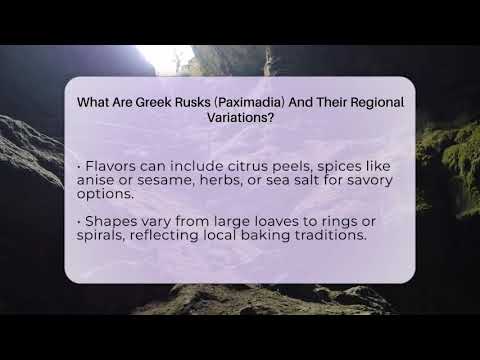What Are Greek Rusks (Paximadia) And Their Regional Variations? Have you ever wondered about traditional Greek snacks and how they vary across different regions? In this video, we’ll explore the fascinating world of Greek paximadia, also known as rusks, and discover how they have become a beloved part of Greek culinary heritage. We’ll start by explaining what paximadia are and how they are prepared, highlighting their unique twice-baked process that ensures long shelf life. You’ll learn about the different ingredients used in various regions, from wheat and rye to barley, chickpea, and even carob flour, reflecting Greece’s diverse agricultural traditions. We’ll also showcase regional variations, such as the popular use of whole grain barley in Crete and other islands’ distinctive flavors, including citrus, herbs, and spices. Additionally, we’ll discuss how paximadia are incorporated into traditional dishes like dakos and how they are enjoyed as snacks with cheese, honey, or fresh vegetables. Their versatility and durability make them a staple for travelers and locals alike, offering a taste of Greece’s rich history and regional flavors. Whether you’re interested in Greek cuisine, cultural traditions, or culinary history, this video provides a comprehensive overview of paximadia and their significance across Greece.
⬇️ Subscribe to our channel for more valuable insights.
🔗Subscribe: https://www.youtube.com/@TalkingGreece/?sub_confirmation=1
#GreekFood #GreekCuisine #Paximadia #GreekSnacks #TraditionalGreekFood #GreekCulture #GreekRecipes #GreekHeritage #GreekTravel #GreekIslands #GreekHistory #GreekFoodLovers #GreekFoodIdeas #GreekFoodTour #GreeceTravel
About Us: Welcome to Talking Greece, your destination for an engaging journey through the rich history, vibrant culture, and timeless heritage of Greece. Our channel is dedicated to providing viewers with a captivating look at the stories, traditions, and landmarks that have shaped this remarkable nation.
Please note that all content on this channel is purely informational and should not be considered as professional advice. We encourage you to conduct your own research and due diligence on any topics discussed. Thank you for being part of our community!
[Music] What are Greek rusks, Paximedia, and their regional variations? Imagine a snack that has traveled through centuries, carrying the flavors of Greece’s diverse regions. Greek rusks, called paximedia, are a staple in Greek kitchens and have a story as rich as their taste. These are twice baked breads that are super hard and dry, designed to last a long time without spoiling. Originally, they were made for travelers and farmers who needed food that could survive long journeys and harsh storage conditions. You can soften paximedia by dipping them in water, wine, or olive oil, making them perfect for different meals or snacks. The ingredients for paximedia change depending on where you are in Greece. The dough can include wheat, rye, barley, corn, chickpea, or even carob flour. These variations reflected local farming and traditions. For example, in Cit Paximedia are often made with whole grain barley flour. These dark dense rusks are packed with fiber and nutrients, making them a healthy part of the diet. They are especially popular because they help with digestion and can lower cholesterol thanks to their betaglucan content. In cit paximedia are used in a traditional dish called tacos. To make it, you moisten a piece of paxamati and top it with chopped tomatoes, feta cheese, olives, capers, and a drizzle of olive oil. This simple dish shows how paxamedia serve as a sturdy base for fresh, flavorful ingredients. Other regions have their own twists. Some islands prefer rusks made only with barley flour, giving them a darker, more intense flavor. Others mix barley with wheat to create a lighter version. You might also find paximedia flavored with citrus peel like orange or lemon or with spices such as anis or sesame. Some are seasoned with herbs or sea salt for a savory touch. Shapes vary too. Some paximedia are baked as large loaves, while others are shaped into rings or spirals. In the past, they were baked in wood-fired ovens alongside bread and pies, filling villages with wonderful aromomas. People enjoy Paximedia as a snack or with cheese, tomatoes, or even honey. Their long shelf life makes them a favorite for travelers exploring Greece. Trying Paximedia in different regions gives you a taste of local culture and culinary traditions. Each bite tells a story of Greece’s history, agriculture, and the four simple hearty food. Whether you’re in Cree or on a small Aian island, Paximedia are a delicious way to experience Greece’s regional flavors. [Music]


Dining and Cooking